Marketing Planner: What’s Best For Organizing Your Marketing?
 If you feel like you have way too much to do in your marketing role and not enough time to do it, you’re in the right place.
You’d love to get organized, but you can’t step back from your daily workload long enough to set up a process that works for you and your team.
In this guide, we’re helping you set up your marketing planner. It will help you prioritize the right marketing tasks, create a repeatable process — so you never forget a task or miss a deadline — and publish content that makes a real difference for your audience.
Want more marketing results and less stress? This guide is for you.
If you feel like you have way too much to do in your marketing role and not enough time to do it, you’re in the right place.
You’d love to get organized, but you can’t step back from your daily workload long enough to set up a process that works for you and your team.
In this guide, we’re helping you set up your marketing planner. It will help you prioritize the right marketing tasks, create a repeatable process — so you never forget a task or miss a deadline — and publish content that makes a real difference for your audience.
Want more marketing results and less stress? This guide is for you.
Grab Your Marketing Planning Templates
While you're at it, make sure to download your very own marketing planning templates, so you can easily keep track of your progress and organize your work. In this downloadable kit, you'll get a:- Content Calendar Template
- Blog Calendar Template
- Content Style Guide Template
- Creative Brief Template
- Marketing Project Checklist Template
- Marketing Plan Outline
- Marketing Strategy Template
What Is A Marketing Plan?
A marketing plan is a documented marketing strategy. The plan lays out target markets and audiences, objectives and goals, budgets, editorial publishing schedules, and processes and procedures. The marketing plan is the operational marketing strategy. The marketing plan is a higher level, bigger picture view of what a marketing team does, why they do it, and how they influence a business's success. A marketing planner is a more granular tool that allows for efficient and effective execution of the plan, often enhancing specific project management best practices.What Is A Marketing Planner?
A marketing planner — or a marketing strategy planner — is a marketing asset that allows you to plan and execute your marketing activities. It’s a tool that puts all of your marketing tasks and due dates in one place. It’s a single source of truth for marketing teams of all sizes — including teams of one. Instead of referring to multiple notes, documents, and emails, you can rely on this central hub to know exactly what it takes to hit your marketing goals.
A marketing planner helps you:
It’s a tool that puts all of your marketing tasks and due dates in one place. It’s a single source of truth for marketing teams of all sizes — including teams of one. Instead of referring to multiple notes, documents, and emails, you can rely on this central hub to know exactly what it takes to hit your marketing goals.
A marketing planner helps you:
- Align all marketing projects and tasks. No more confusion, tasks that fall through the cracks, or focusing on low-priority projects.
- Ship more projects in less time and without stress. Every team member always knows what to work on next, which reduces friction and increases focus, deep work, and creativity.
- Share progress with higher-ups. You can easily give status updates to your managers and executives, since you can view what you’re working on and what happens next at a glance.
In the following year, we will ______ because _______.Here’s an example to get you started:
In 2023, we will focus on in-depth, actionable, step-by-step content because we want to help our audience solve their problems themselves while seeing our product as a tool that can help them take control.This is your vision, and a marketing planner will help you make it a reality.
Types Of Marketing Planners You Can Choose From
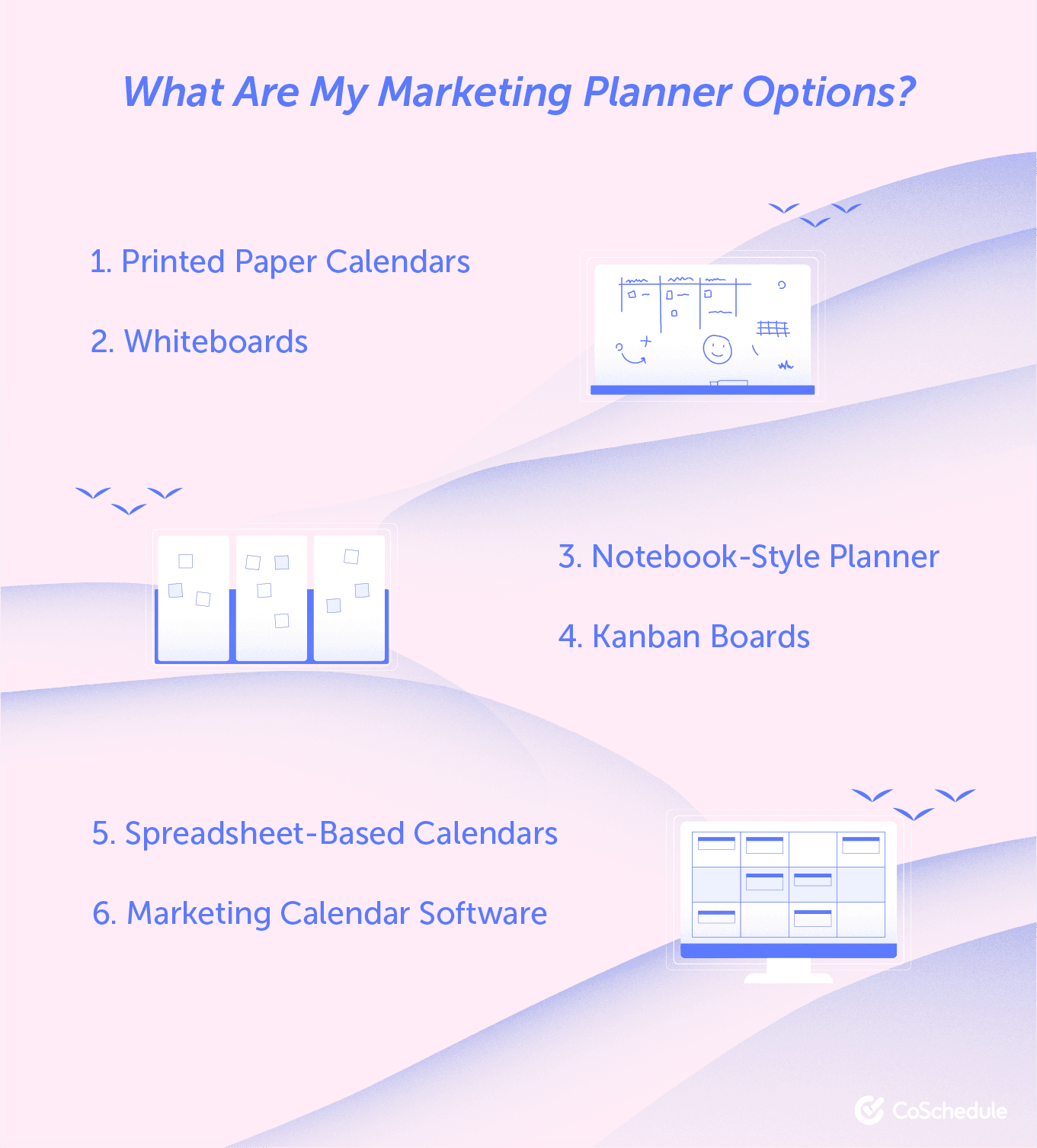 Here are six different versions of a marketing planner — ranging from physical products to software solutions.
Here are six different versions of a marketing planner — ranging from physical products to software solutions.
Printed Paper Calendars
If you’re already using printed paper calendars in your personal life, you may want a marketing version of such a planner. Your paper calendar may have a monthly, quarterly, or yearly overview. From there, you can use it to plan and map out:- Your publish dates for blog posts, emails, videos, and any other content format you use.
- Key dates for product launches.
- Seasons/holidays relevant to your industry (i.e. Black Friday, Mother’s Day, and social media holidays, like International Coffee Day or National Dentist’s Day).
If you change one plan, don't forget to check that this change will not affect other plans.
Click To TweetWhiteboards
Whiteboard marketing planning works really well for teams that think in a visual way and like to keep their processes agile.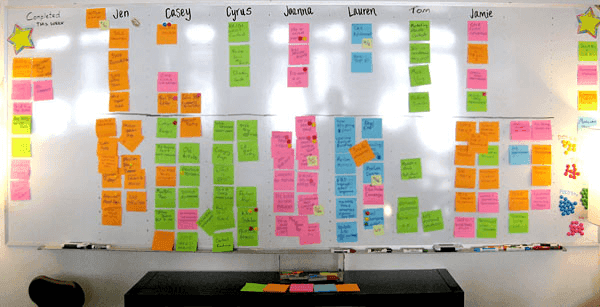 Image source
You can use whiteboard pens, sticky notes, or both to make the most out of your whiteboard marketing planner. You can structure in a few different ways:
Image source
You can use whiteboard pens, sticky notes, or both to make the most out of your whiteboard marketing planner. You can structure in a few different ways:
- Type of content: blog posts, emails, videos, whitepapers, etc.
- Team members
- Team roles: strategist, writer, designer, editor, etc.
- Process stage: idea backlog, next up, writing, designing, editing, final approval, and published
- Marketing personas
Physical Notebook-Style Planners
Next up on the physical side of planner options: a notebook-style marketing planner. This is a portable, compact version of a printed paper planner. They’re quite popular among solo bloggers and entrepreneurs, and you can even find content-specific planners on the market. Here’s one from The Content Planner: Image source
Another variation is the one from Content Creators Planner:
Image source
Another variation is the one from Content Creators Planner:
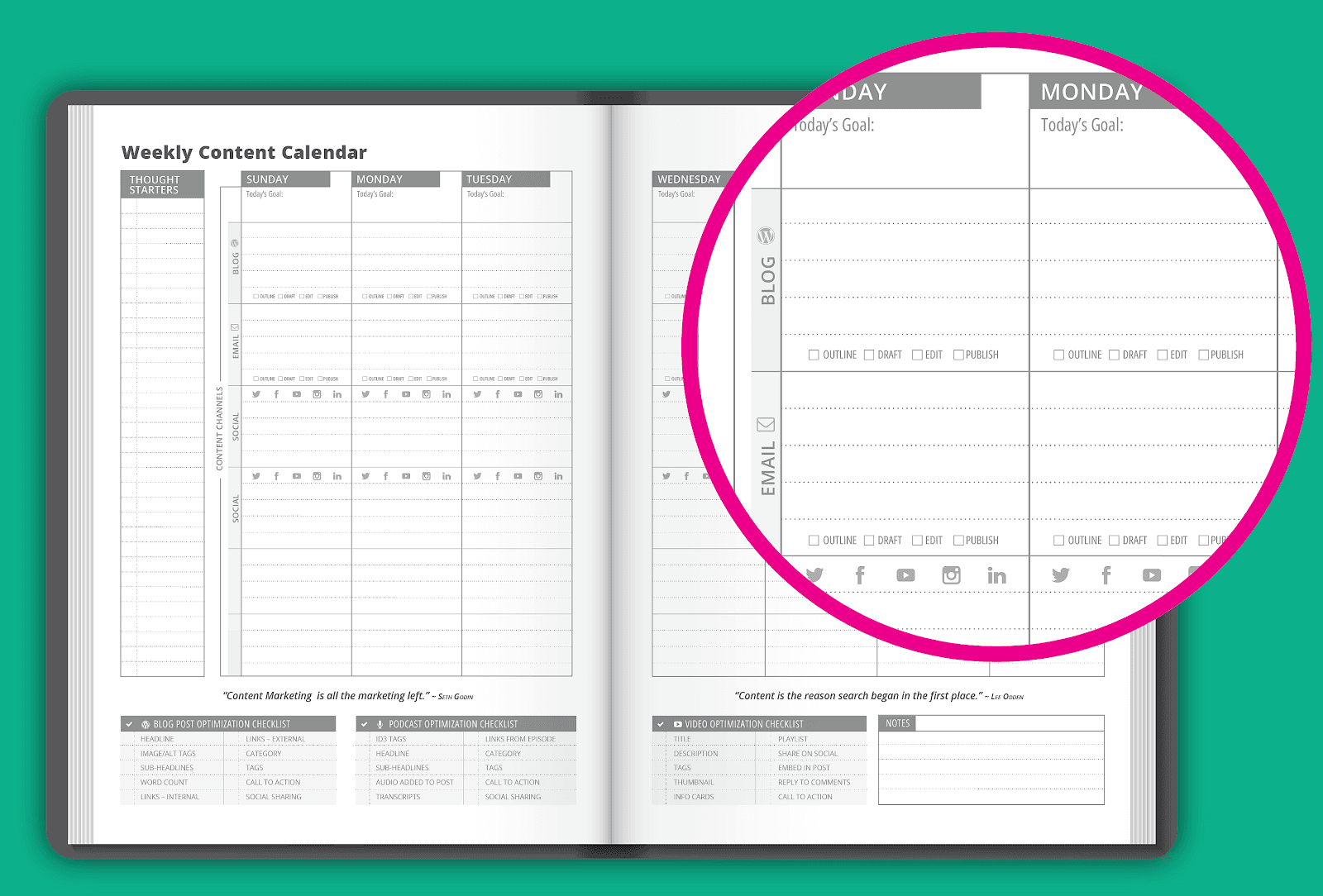 Image source
These planners wouldn’t work for a team because they don’t allow for collaboration and idea sharing. Just like anything else done on paper, a notebook planner version takes a bit longer to update in case anything changes in your campaigns, timelines, or launches.
Image source
These planners wouldn’t work for a team because they don’t allow for collaboration and idea sharing. Just like anything else done on paper, a notebook planner version takes a bit longer to update in case anything changes in your campaigns, timelines, or launches.
Notebook-style planners do not allow for collaboration; keep this in mind when choosing your marketing planning strategy.
Click To TweetKanban Boards
A marketing kanban board allows you to move projects through workflow stages — from left to right and beginning to end. A kanban board is made out of columns that represent stages in your marketing process, and cards in these columns represent projects. In this case, you’d have:- Marketing process stages as columns: write, design, edit, review, publish
- Marketing project as cards: blog post on [topic 1], email campaign that promotes that blog post, YouTube video interview with [expert]
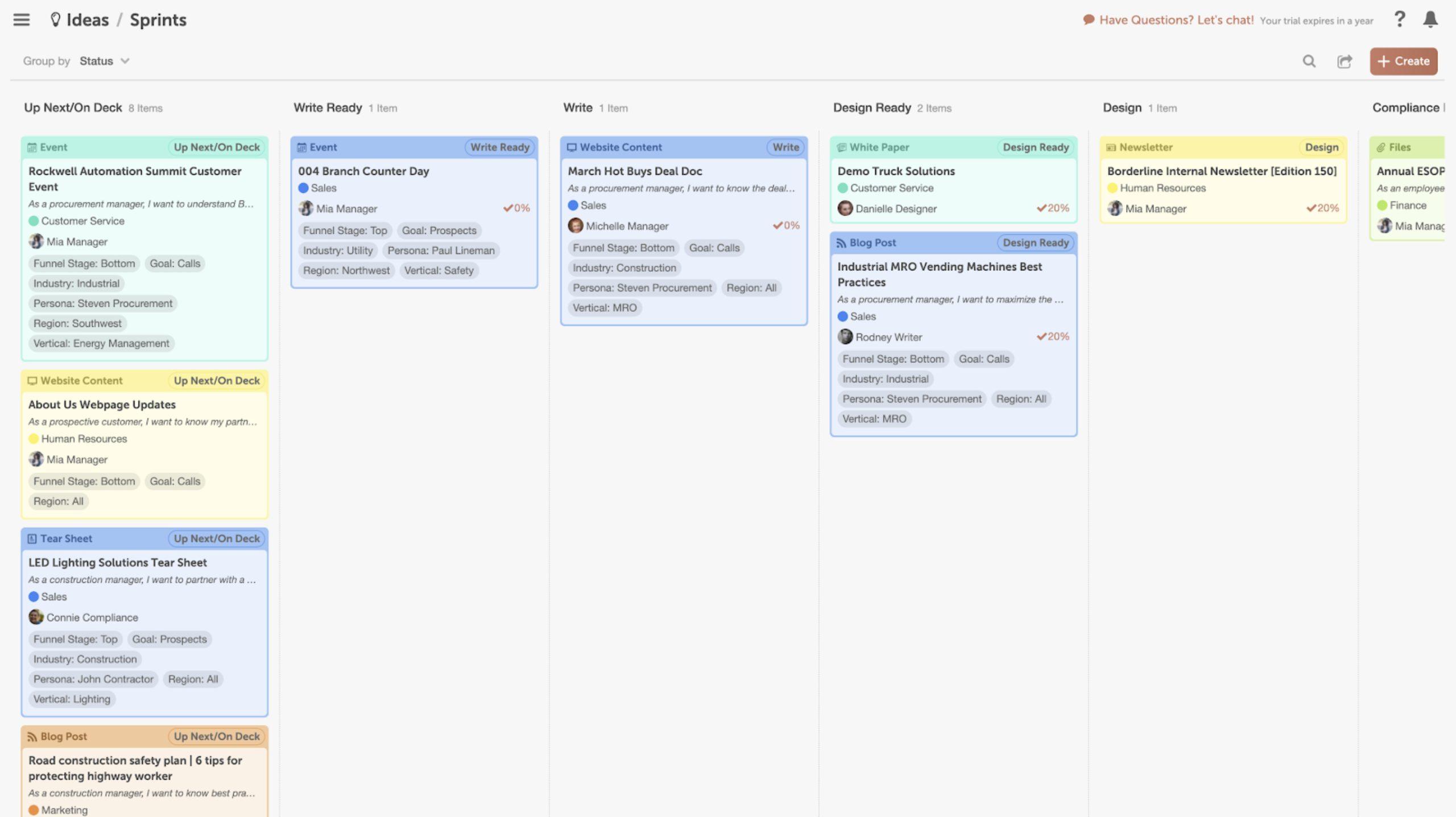 There are also other tools, like Trello, that allow you to build your own marketing planner as a kanban board from scratch.
There are also other tools, like Trello, that allow you to build your own marketing planner as a kanban board from scratch.
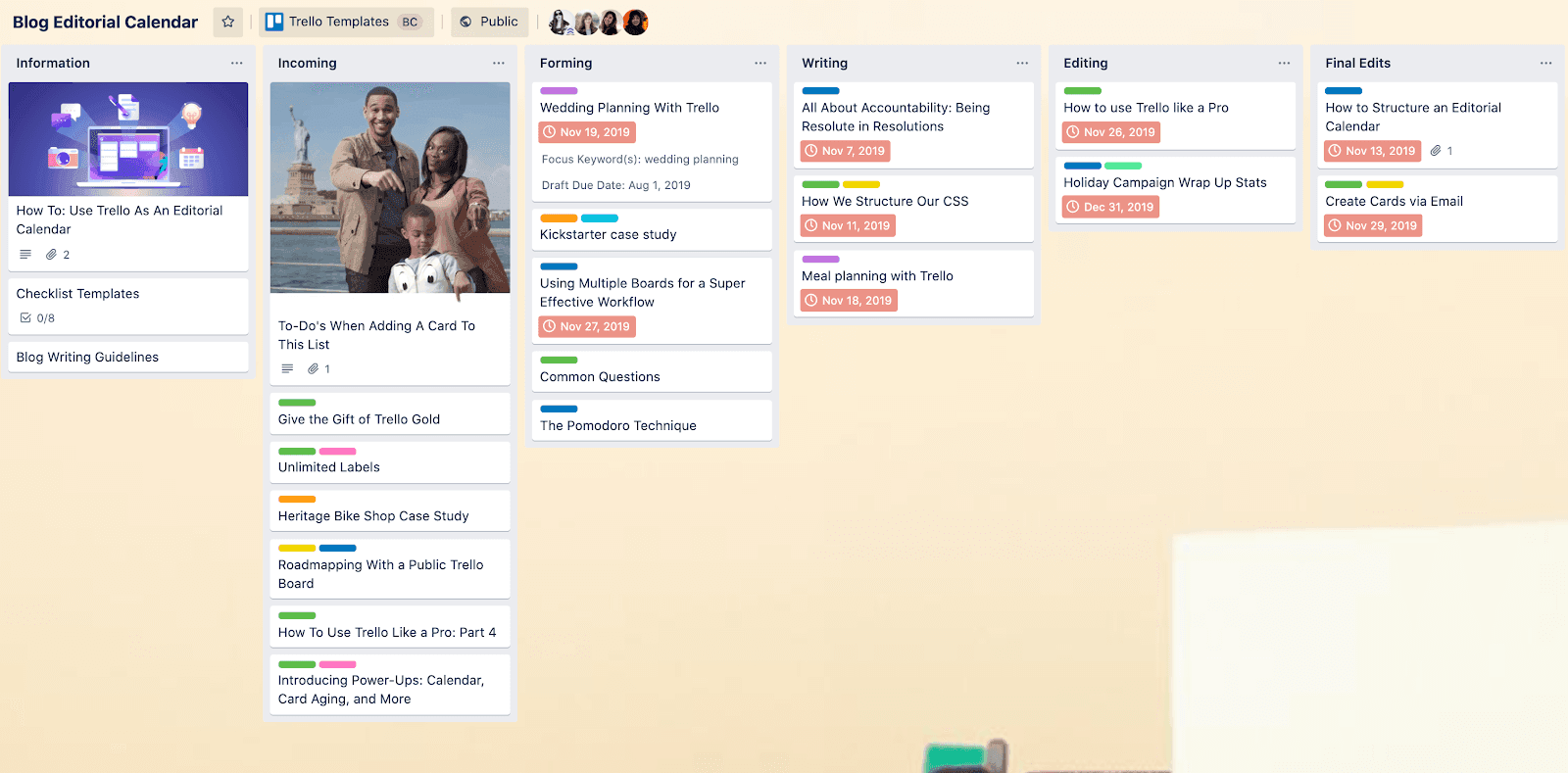 Marketing planners as a kanban board is an excellent way to empower teams of all sizes, in-house or remote, to always know what’s on their plate and what to prioritize to maximize results of their marketing campaigns.
Marketing planners as a kanban board is an excellent way to empower teams of all sizes, in-house or remote, to always know what’s on their plate and what to prioritize to maximize results of their marketing campaigns.
Spreadsheet-Based Calendars
If you like the idea of a digital marketing planner, but you don’t want to be limited by kanban boards, you can use a spreadsheet-based marketing calendar. Spreadsheets give you the advantage of flexibility. You can organize it in many ways.- As a calendar — with columns as days of the week and rows as different weeks.
- As a list of topics with priority levels, people in charge, current status, and more.
- As a list of monthly themes — with separate tabs for each month.
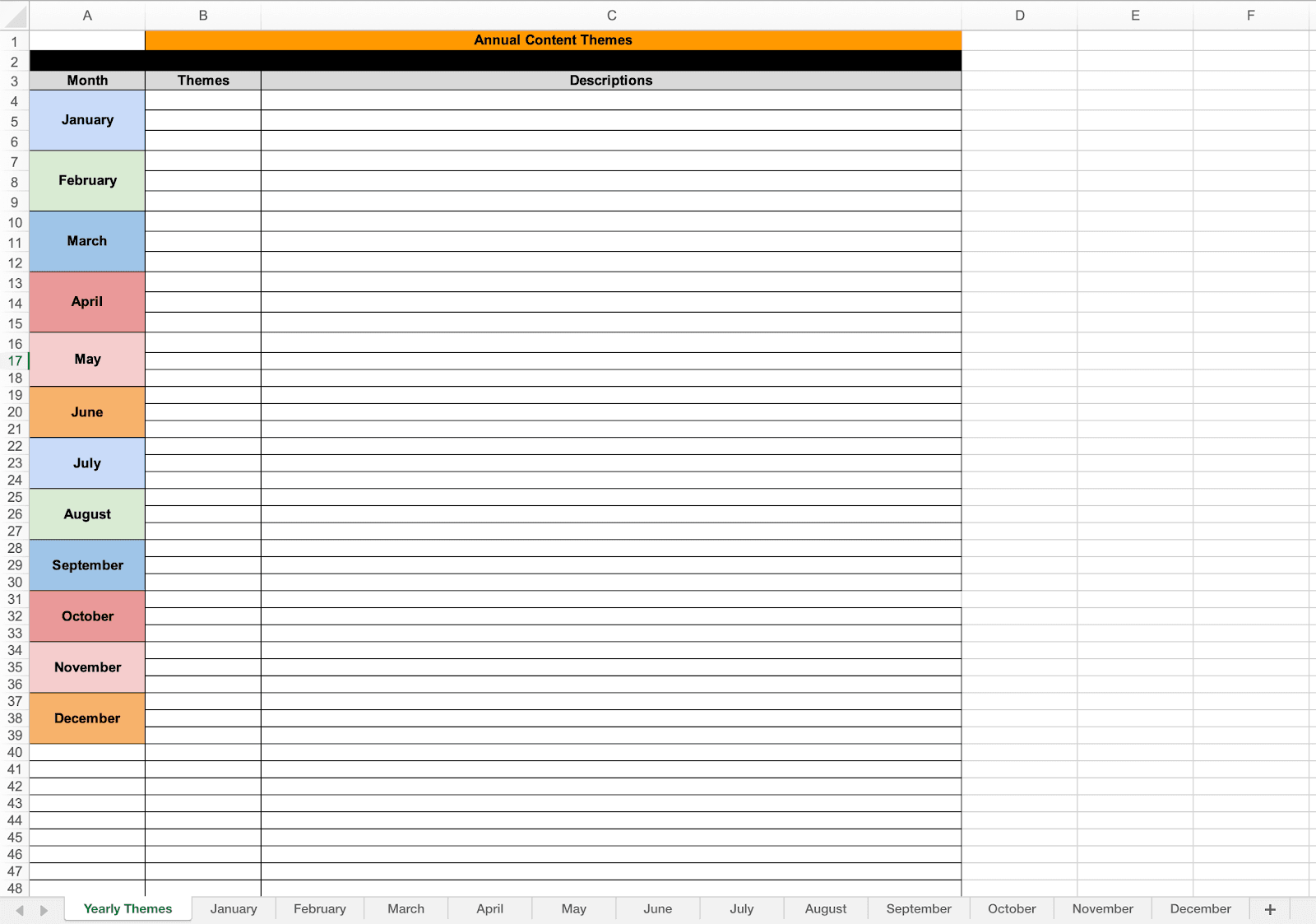 The great thing about spreadsheet-based marketing planners is that they can live in the cloud and be accessible to your entire team thanks to services, like Office 365 and Google Drive.
The great thing about spreadsheet-based marketing planners is that they can live in the cloud and be accessible to your entire team thanks to services, like Office 365 and Google Drive.
Marketing Calendar Software
Finally, there’s the option of a marketing calendar software with features tailored to you and your marketing team’s needs. This option is the ultimate central place for all your blogging and social media activity. It’s your go-to, everyday hub for everything you do as a marketing team. If you choose an option like CoSchedule’s Marketing Calendar, you’ll be able to:- Switch between calendar and kanban view.
- Move dates, campaigns, and tasks with a simple drag-and-drop.
- Have a big-picture overview of content formats, social media campaigns, individual tasks, and more on a timeline.
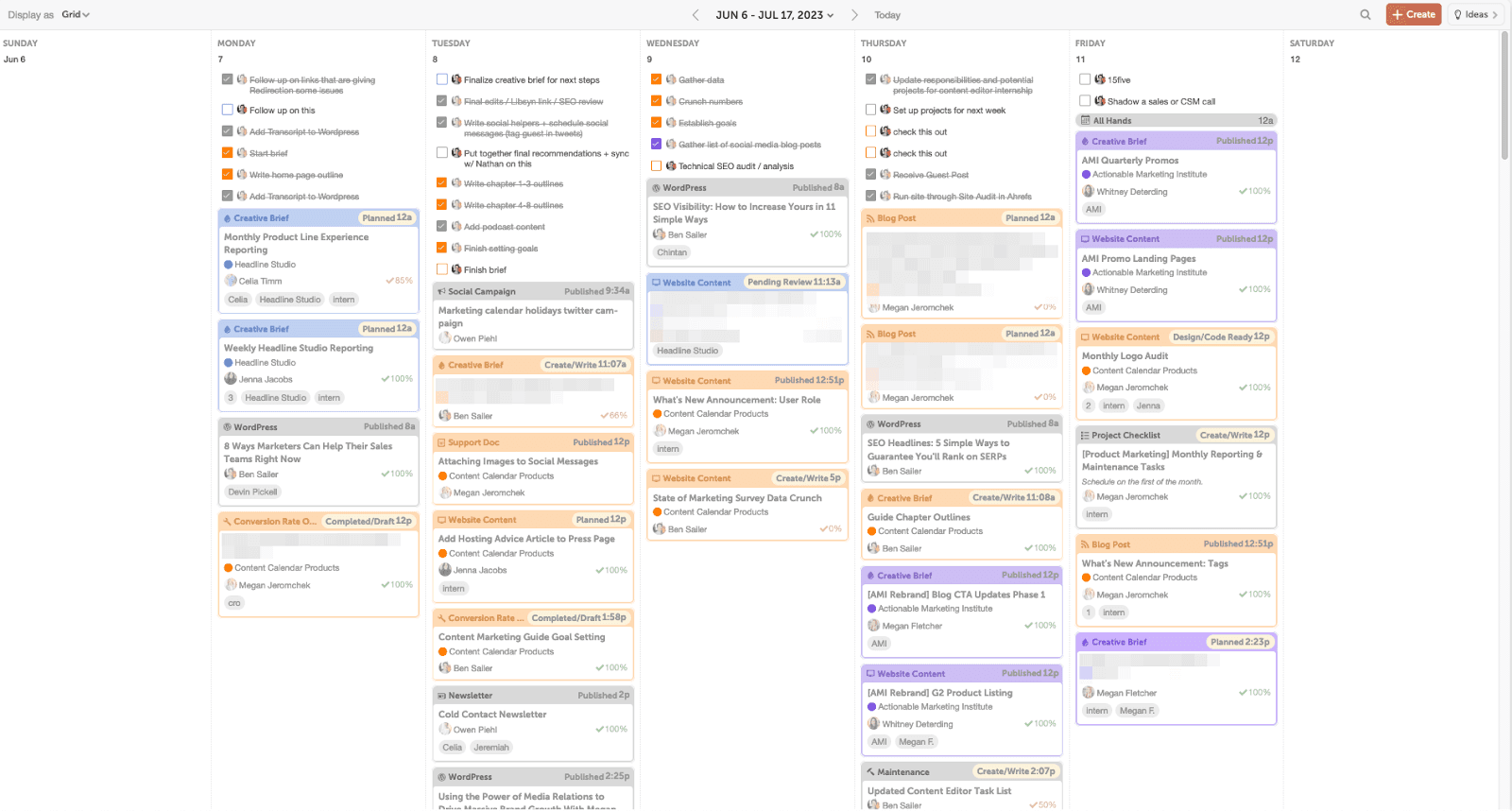
How To Use A Marketing Planner: 5 Steps to Get Started
Now that you know the type of marketing planner that suits you best, here’s how to get started, so you can make the most out of it.1. Start With A Simple Content Strategy
Your marketing planner will make you laser-focused and organized, but only if you use it in a strategic way. In other words, you need to know what you’re looking to achieve with your marketing campaigns. That’s the only way you can see results. Here’s a simple approach to content marketing strategy you can take.- Determine your business objectives. Do you want to reduce churn? Drive more revenue? Increase customer lifetime value? Something else? This will help you map your content to the right part of the funnel.
- Identify your target audience. What are their challenges? Demographics? Pain points? Where are they searching for solutions, and in what format? How can you help?
- Determine your content core. It’s an overlap between what your audience cares about and what your business provides. Define topics and categories most closely related to your product.
- Pick your content formats and channels. Consider blog posts, email newsletters, videos, social media content, print materials, ebooks and whitepapers, case studies, and visual content.
- Establish a regular publishing schedule. Go with something you can maintain in the long run — one blog post per week is a great way to start, and you can always build up towards more later. Create a publishing cadence you can sustain for all the formats you picked.
- Determine who’s involved in your content production process. Are you a marketing team of one? Do you have editors, designers, and social media writers? List all the people that will be included on your marketing calendar.
2. Plan Marketing Projects Based On Your Strategy
You have your goal, target audience, content core, and formats. It’s time to use these to brainstorm and plan your marketing projects. Feel free to use your own brainstorming technique or steal the content brainstorming process from CoSchedule. If you choose the latter, it’s simple:- Write down as many ideas as you can in 10 minutes. Don’t hold yourself back — just write down everything that comes to mind.
- Score your ideas with a 1, 2, or 3 in 10 minutes. 1 is weak, 2 is average, and 3 is exceptional.
- Take 10 minutes to prioritize and think about all your 3s. Brainstorm potential headlines, angles, and resources that will make these topics stand out.
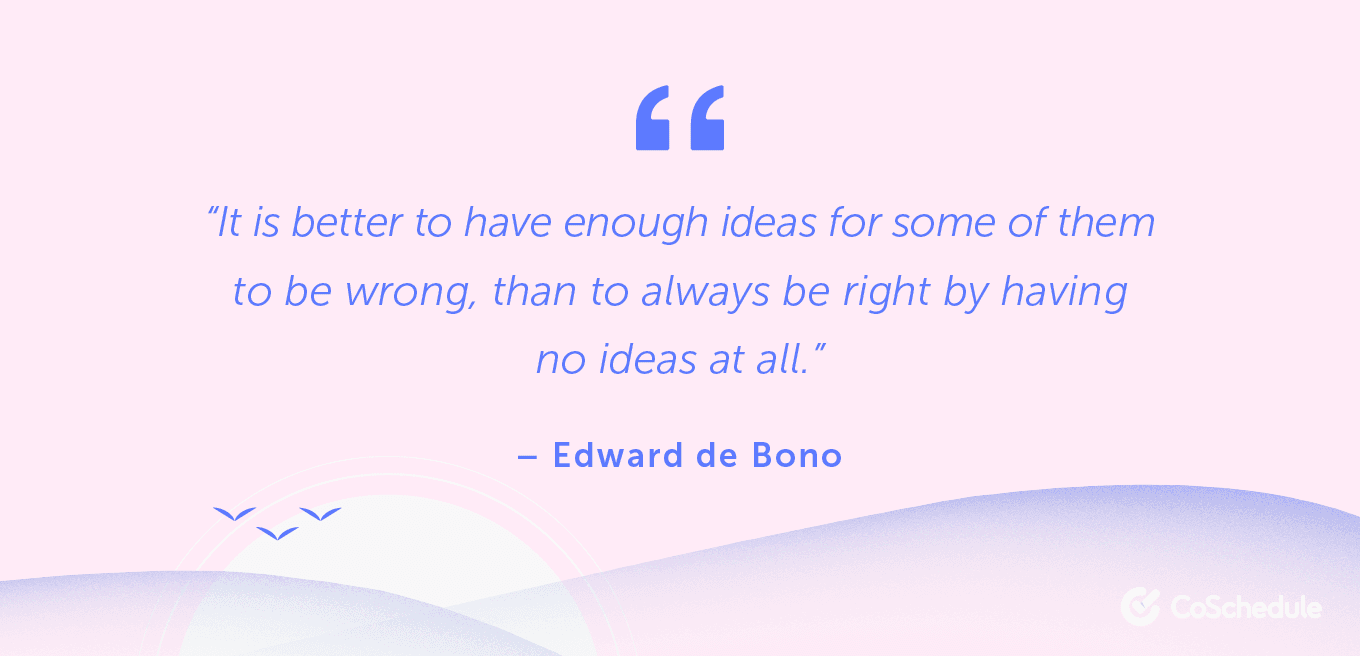 When you have a list of great content ideas, think about formats and channels that will best fit these topics. Here are some questions to consider:
When you have a list of great content ideas, think about formats and channels that will best fit these topics. Here are some questions to consider:
- Is this idea best covered in writing, video, or audio?
- Is there potential to turn this topic into a series with more than one piece of content?
- Can I interview experts or add other external resources to make this topic even more useful to my target audience?
- Is this topic more relevant in certain times of the year, and should it be prioritized during these times?
- Does this topic support the top, middle, or bottom of our marketing funnel?
Repurpose the content you publish on one channel so you can publish it to other channels, too!
Click To Tweet3. Create Checklists For Each Marketing Project
Don’t want to forget a task for one of your new marketing projects? If so, you’ll love checklists. Marketing tasks are crucial to take your content topics from idea to reality. These tasks are all the individual steps you need to take to publish a blog post, send an email newsletter, publish an ebook, and so on. You’ll want to get this part of your marketing planner right; marketers that proactively plan projects and tasks are 356% more likely to report success. By turning your marketing tasks into checklists, you’ll outline your process once and simply follow it each next time you’re working on that specific content format again. Nothing will slip through the cracks... ever. Here’s how to build your own marketing project checklists:- Identify all the types of projects you have. Like blog posts, YouTube videos, email newsletters, social campaigns.
- List all the current steps per project type. For example, a blog post will have keyword research, outline, writing, editing and proofreading, design, CMS formatting, scheduling.
- Clean up your list of steps per project type. Are there any steps that could be removed? Can you consolidate some of them?
- Determine who’s in charge of which step. Think about your SEO strategist, content strategist, writer, designer, editor, and any other roles you have.
- Add time estimates to tasks. Does a task take 30 minutes? An hour? Three hours? More? This will help you and your team schedule these tasks in the workday.
- Determine task deadlines. How long before the publish date does each task need to be completed?
- Task 1 (30 minutes), [person 1], 10 days before publish
- Task 2 (1 hour), [person 2], 7 days before publish
- Task 3 (2 hours), [person 1], 7 days before publish
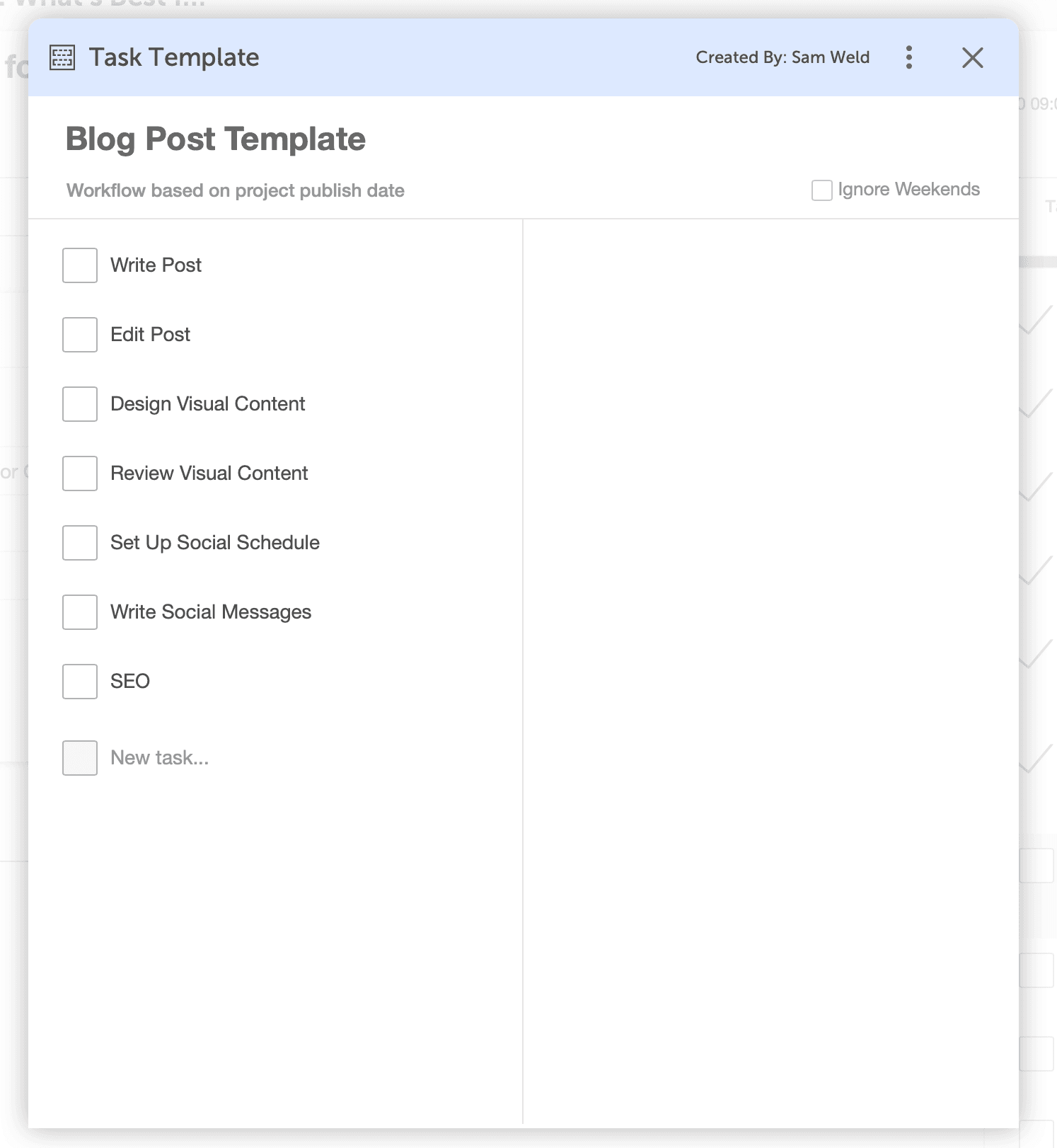
4. Document Deadlines With Your Marketing Planner
You can now start building out your marketing planner. Based on the publishing cadence you defined, take the marketing projects you’ve planned and define publish dates for them on the planner. Then, take your checklists into account and start adding all marketing tasks for those projects into the calendar, too. If you have a marketing team, these tasks and deadlines should be public and easy to access by every team member. Having a team-wide marketing calendar will help you:- Understand the bandwidth of each team member at any given point.
- Make sure no one is overloaded with tasks.
- Notice potential bottlenecks and avoid delays and missed deadlines by reassigning tasks.
5. Start Shipping More Projects & Remove Stress
As you start taking action with your marketing planner, you’ll ship more marketing projects than before, with less stress, and on time — every time. To make sure your marketing planner is always helping you hit your marketing goals, be sure to revise it regularly and catch any fluctuations so you can adjust quickly:- Are certain tasks taking shorter or longer than you originally anticipated? Take note of it in your checklists.
- Are some formats or channels bringing better results than others? Tweak your strategy and double down on what works.
- Has your bandwidth increased or reduced? Revise your publishing cadence.
Marketing Planner FAQs
What does a marketing planner do?
A marketing planner organizes the editorial schedule of content to be published. A marketer who plans marketing may occasionally be called a "marketing planner"; however, it's a best practice to think of a marketing planner as a framework or tool that empowers that marketer to proactively schedule marketing activities to influence the goal of marketing—to influence profitable customer action. The role of marketers who use marketing planners vary, but marketing project managers are highly likely to use marketing planners.What are the 7 elements of a marketing plan?
The 7 elements of a marketing plan generally refer to the marketing mix and the 7 Ps of marketing. The 7 Ps of marketing are product, price, place, promotion, packaging, positioning, and people. However, a comprehensive marketing plan document also features 7 elements and components. The 7 marketing plan elements are:- Business components
- Marketing outcomes components
- Market focus components
- Product focus components
- Marketing methods components
- Action plan components
- Accountability components.


